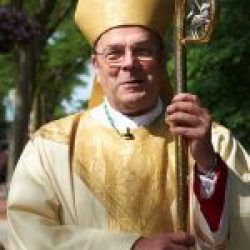“Overcome by darkness.” This phrase came to mind as I started to think about this week’s article for the Catholic Sun. I am sure you have noticed that December days are shorter and the hours of darkness are longer. Moreover, other forms of darkness permeate our thoughts these days. It is a darkness marked by disrespect for the dignity of the human person, the threat of war, the devastation of homes and lives lost through natural disasters, political and religious tensions, as well as personal worries and anxiety.
Although every liturgical season has its particular character and beauty, Advent has always been for me a special time. It invites me once again, in the midst of darkness, to renew my awareness that God is present. He came into the world, becoming a man like us, to bring His plan of love to fullness.
The early days of Advent will direct our thoughts to the future, to the coming of Jesus in glory at the end of time. The first Eucharistic Preface of Advent draw our attention to Christ’s triumphant return: “When he comes again in glory and majesty and all is at last made manifest, we who watch for that day may inherit the great promise in which we now dare to hope.”
After December 17, the second Eucharistic Preface looks to the past and the familiar accounts of the events leading to the coming of God among us as a child. It describes Mary’s longing for her child during her pregnancy “with love beyond all telling” and John the Baptist who “proclaimed his presence when he came.”
Whether our attention is drawn to future days and Jesus coming in glory or to the past and His birth, Advent reminds us that God’s coming is not a distant gift of the past. Nor is His presence only a future gift that arrives when He comes at the end of time. The gift of God’s presence does not belong purely to the past or the future: it penetrates the present time too.
Many of the early doctors of the Church speak of multiple “comings” of Christ. St. Bernard, for example, refers to three comings: Christ’s birth when He came in our flesh and took on our weaknesses, His final coming in glory and majesty at the end of time, and His coming into our hearts when we are open to receive Him. The first coming is a past event and therefore we do not wait for it. Nonetheless, we need to recall it, to commemorate it, to kneel at the crib and bring to mind who the child is and what He did for us.
“God ‘comes’: he comes to be with us in every situation of ours, he comes to dwell among us, to live with us and within us; he comes to fill the gaps that divide and separate us; he comes to reconcile us with him and with one another” (Pope Benedict XVI, Angelus, December 3, 2006). Are we ready to welcome God who comes to us in His word and sacraments and through our brothers and sisters in whom He lives?
Pope Francis notes that we may often feel lost, discouraged, and powerless and “it seems the darkness might never end.” However, he continues we should never give up hope “because God, with His love, journeys with us. He does not leave us and the Lord Jesus has overcome evil, and opened up the path of life” (General Audience, December 7, 2016).
For a time the hours of daylight decrease and darkness increases — but only for a time. With the celebration of Christ’s birth, the light of the world arrives and darkness is overcome.
Let’s ask Our Blessed Mother to walk with us during this Advent season. She will show us how to listen to God’s word, to cherish it, and to put it into practice. She will help us to be attentive and alert so we can commemorate Jesus’ birth with renewed joy and hope. She will help us to live God’s word in the everyday circumstance of our lives so we will be prepared for His final coming. She will walk with us as a loving mother helping us to recognize the many ways through which her Son comes to us.
Come, Lord Jesus! May the glory of your presence drive out the darkness and fill us with hope and joy!
If you have a prayer intention you would like me to consider during the weeks ahead, please mail it to my attention at 240 E. Onondaga St., Syracuse, N.Y. 13202.
Year of the Family begins December 3
With the publication of his new pastoral letter, “Enriching the Church: The Role of the Family in the Life of the Church of Syracuse and Beyond,” Bishop Robert J. Cunningham has announced a special Year of the Family to begin in the diocese on Dec. 3.
Copies of the pastoral letter have been provided to parishes, and resources for celebrating the year are available at syracusediocese.org/year-of-the-family. Resources include a video message from Bishop Cunningham, a Prayer for the Family, and an explanation of the Holy Family icon used with the prayer. Additional resources will be provided throughout the year.
Prayer for the Family
O God, who was pleased to give us
the shining example of the Holy Family,
graciously grant that we may imitate them
in practicing the virtues of family life.
Transform our doubt to faith; Strengthen our hope;
Help us to live in charity.
Until we are all one in your kingdom
through Jesus Christ, your Son,
in the unity of the Holy Spirit,
One God, for ever and ever.
(Adapted from the Roman Missal, on the Feast of the Holy Family of Jesus, Mary & Joseph)





